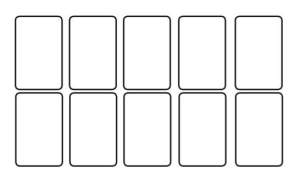
This is both an exercise and a way of reading the cards. As an exercise it is a very powerful way to learn to think about connections between cards and the way that influences meaning. As a way of reading the cards, this is particularly useful for large, complex and fluid situations where the questions can sometimes feel nebulous. I haven’t called this a ‘spread’ because the way tarot spreads are usually presented in books is quite rigid and fixed – this position is about such-and-such, and this one is about this other aspect. Some people might find it difficult for this reason, but part of the learning with this technique is to shake off some of the expectations we can put on ourselves about precision and accuracy in a reading. It is an attempt to get past ‘this means this’ and ‘that means that’.
Think of a situation which is multi-layered and complex. For example, what can the cards tell me about my workplace? Or, what can I learn about the relationships in my extended family? The technique has also been very powerfully used as a way of extending a significant dream and as a way of allowing a tutelary spirit to speak.
As you begin to think about the matter in hand start laying the cards down. Larger format cards work well if you have them. After you have tried it a few times as described here, feel free to start in a different way but for now, lay ten cards down in two rows of five. Key to this method is to feel free to not ‘read’ every card.

Once there are ten cards in front of you allow your eye to roam a little. Get a sense of whether there is movement in these images – left to right, or right to left. Is there maybe a difference between the top and bottom row in some way? Do pairs or groups of four seem to band together at all? Is there any sense of narrative? Is there a beginning, a middle and an end to these cards? And as you survey the cards on the table in these terms, begin to think about how they might apply to the situation you are thinking about. Do not read every card. Do not feel obliged to include an interpretation of every card in your mind before you move on. Often you will have a sense of what there is to say without actually being able to formulate it, or you will know what is being said in a part of the cards but might not be able to articulate how that relates to the particular cards on the table. This does not matter.
Move on to the laying of more cards before you have a fixed idea about each of the first ten cards. Lay four more on top. We are now beginning to get depth. Laying four cards like this gives you triads as well as pairs and fours. You will see how cards which are now behind the new cards feed into the cards on top of them. Just one of the new cards has four cards underneath them and maybe that is an obvious group. Do the four new cards change any of the narratives you had previously begun when there were only ten on the table? Again, do not try and read every card, and certainly do not try to read every card on its own. In fact, don’t read any card in isolation. Allow your mind to wander over the situation at hand and the cards on the table. Do not be concerned if you cannot articulate what the cards say.

Again, move on to more cards before you have exhausted all the thinking about the first fourteen. At this point the symmetry begins to breakdown (though it can be maintained a little longer by things like four more cards at the corners). Use your sense of the groups of cards, now in three dimensions, to judge where to put new cards. Don’t try for exact symmetry but do try for balance across the cards. Keep going as long as you feel you are learning something about the situation and the cards.



This is both a way of reading and an exercise to help learn about the cards and their interactions. If you are using it primarily as a learning exercise, it is worth keeping a piece of paper to one side. Make a record of any interesting relationships and groups which come out of the layers. So, for example, you might find a card which you usually find very negative lays on top of two others which make you feel differently about it and, more importantly, begin to see how the three cards together have a meaning which transcends any one individually. It is hard enough to get a grip on 78 basic meanings and no one is suggesting that you try and learn what every possible combination of three or four or more cards might mean. The art here is to realise that groups of cards make pictures that may be very different to the meaning of any one of the constituent cards on their own.

